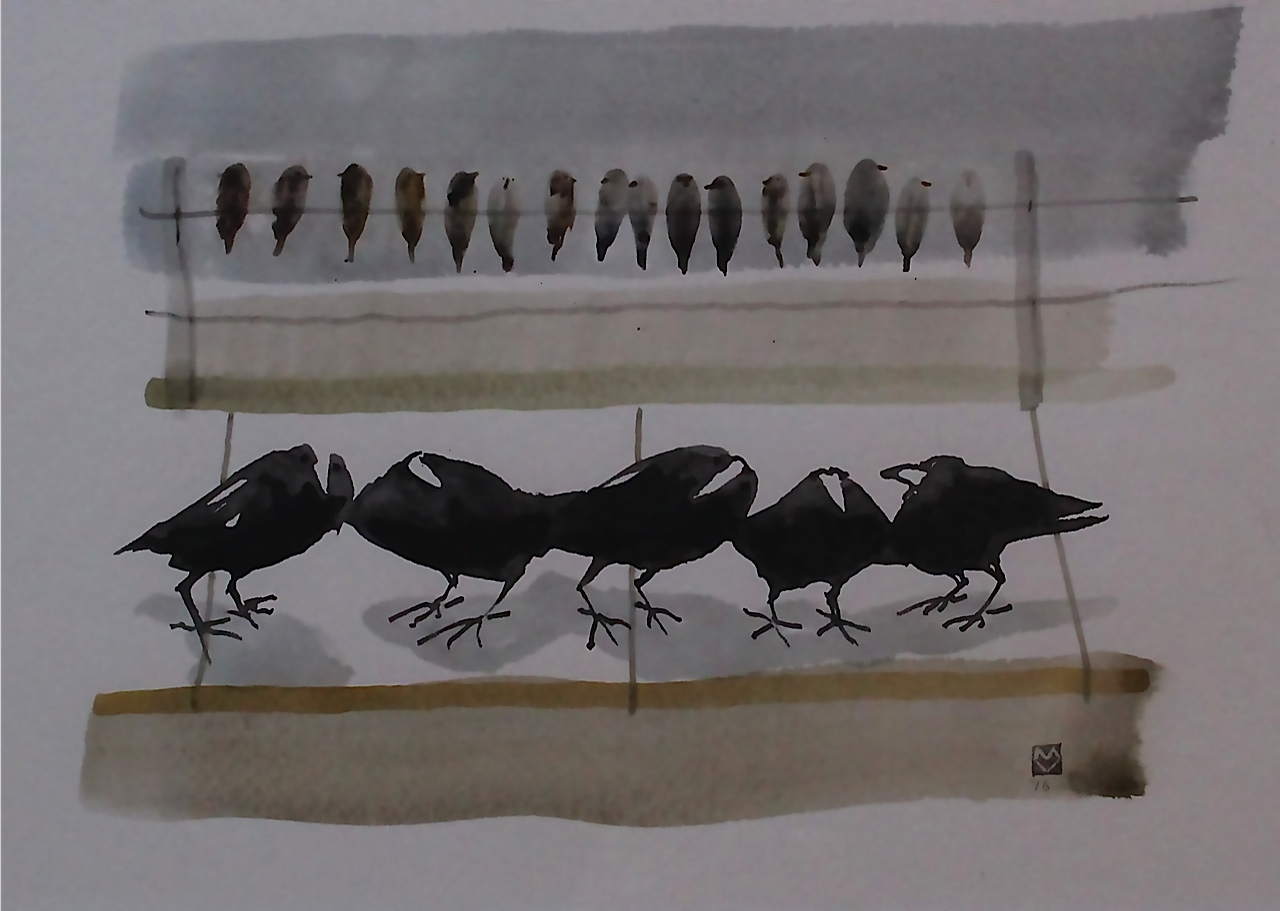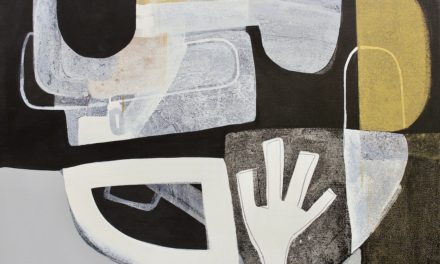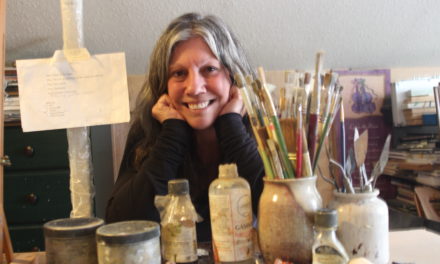By Randi Bjornstad
Two local artists — one a longtime, beloved high school teacher and the other a dental office worker who didn’t begin her exquisite printmaking career until she was in her 50s — are sharing the walls at the White Lotus Gallery through Nov. 29.
Gallery co-owner Hue-Ping Lin knows both Mike Van and Connie Mueller well and has watched their careers develop and mature.
Van, who taught for decades at South Eugene High School, specializes in watercolors, oils and ink drawings that often — but not always — feature birds. This show has plenty of birds, but also several intriguing ink and watercolor portraits. Many of his works also have hidden images within the larger pictures.

Mike Van’s “Flock” combines images of his beloved birds with women’s faces
“Mike (Van) has been an important artist since he taught at South Eugene High School in the 1970s,” Lin said. “He is highly respected both for art and for being a wonderful teacher— his former students are coming from all over to see this work.”
She first met Van when both volunteered at the Jordan Schnitzer Museum of Art at the University of Oregon. White Lotus has represented his work for more than 10 years.
Connie Mueller has mastered what Lin and gallery spokeswoman Claudia Ponton both consider one of the most difficult of all printmaking methods, the reduction linocut. Many artists refer to the process as as “suicide prints” because the print block — made of linoleum — is cut away a layer at a time before each color of ink is applied. If there’s a mistake, there’s no going back to repair it, so the entire piece of art is ruined, or at least irrevocably changed.

(Photo by Randi Bjornstad)
White Lotus Gallery’s Claudia Ponton shows a finished Connie Mueller linocut print with the linoleum carving used to make it.
The reduction linocut not only means visualizing the final print as the two-dimensional mirror opposite of the linocut, it also requires the artist to imagine the work-in-progress in terms of its vertical layers.
“It’s called reduction because in every layer, the artist continues to reduce the amount of surface area that is available to the ink — the part that is carved away is where the ink won’t be retained,” Lin said. “So there has to be an understanding layer by layer what the effect of adding an additional color will be to the parts that remain uncarved.”
She laughed about the complexity of the process.
“I sound like I know, but I still don’t really know,” she said.
Some of Mueller’s impressions require as many as 24 separate carvings and applications of ink, making them incredibly difficult to keep coordinated in terms of color and registration from one layer to the next, Ponton said.
“I think it’s so amazing that Connie (Mueller) had her first career and then so much later started taking classes at Lane Community College to learn how to do this really difficult form of art,” she said. “And she just keeps getting better and better. Her talent is really wonderful.”

“Farm off Helmick Road” is one of Connie Mueller’s reduction linocuts on exhibit at the White Lotus Gallery
(Photo by Randi Bjornstad)
Until the late 19th century, most printmaking was done with wood blocks, but the grain in wood and its tendency to split made the task more difficult. Interestingly, it was Pablo Picasso who apparently helped make the use of linoleum, which had been used as a floor covering since the 1860s, popular for printmaking.
Linoleum is soft and therefore easier to cut than wood, but it isn’t as durable, so limited editions tend to be much smaller when it’s used for block printing.
French artist Henri Matisse and Dutch artist M.C. Escher also favored the reductive linoleum technique.
Most of Mueller’s linocuts take the form of lush landscapes, many of them local to Oregon. There’s “Farm off Helmick Road,” “Harney Valley,” “Powell Hills Oak Grove” and a glorious glorious rendition of “Smith Rock I.”
Her limited editions are available in lots mostly of eight to 10 linocut prints.
Among Van’s for-sale artwork is “Sidewalk and Fence,” a pleasing ink-and-watercolor painting of crows on a sidewalk under a fence inhabited by lots of smaller birds apparently ready for migration and “Flock,” an oddly similar construction of women’s faces, also in ink and watercolor with birds hidden in plain sight in the foreground branches.
The most unusual of Van’s pieces in the show is “Milking Time,” an autobiographical watercolor from his youthful years in Idaho, depicting him, his parents, brother and the family dog in a daily chore on the dairy farm.
White Lotus Gallery
What: Art by Mike Van and Connie Mueller
When: Through Nov. 29
Where: 760 Willamette St. in downtown Eugene
Hours: 10 a.m. to 5:30 p.m. Tuesday through Saturday
Information: 541-345-3276 or wlotus.com








